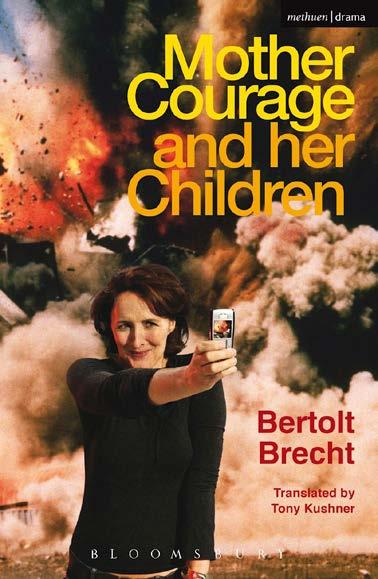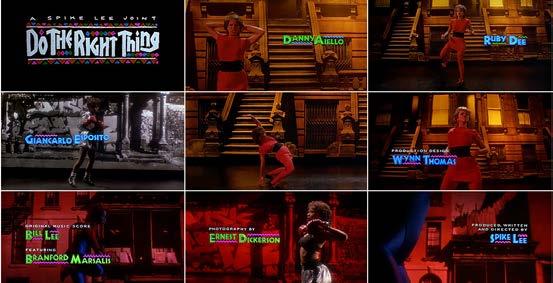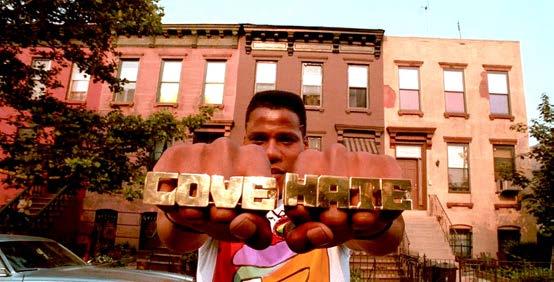ACADEMIC ESSAY
Mia Burwise 231098

Mia Burwise 231098
“Do the Right Thing”, directed by Spike Lee, remains profoundly influential and frequently studied since its 1989 release (Toby, 2019). Until this day the film has a lasting impact prompting ongoing discussion about controversial political topics (Shaw, 2021). The question is however, how did Lee achieve this? By employing Bertolt Brecht’s epic theatre techniques, which are designed to make audiences think critically about social conditions rather than escape into the narrative (Flory, 2006). Brecht’s “Verfremdungseffekt” or “estrangement effect” is the core concept and sought to distance the audience emotionally to encourage rational thought and critical reflection (Platinga, 2019). Brecht achieves this distance by techniques, such as breaking the fourth wall, montage, and the use of music to remind the audience of the film’s constructed nature and the complex issues it addresses (Marsden, n.d.). Audience theory complements this with Stuart Hall’s encoding/decoding model that asserts “before this message can have an ‘effect’...it must first be appropriated as a meaningful discourse and be meaningfully decoded” (Hall, 2003). Rushto&Bettinson (2010 pg.53) suggests that spectators are actively engaged in making sense of the film. In this essay I will analyse how Brechtian techniques and audience theory combine in “Do the Right Thing” to disrupt passive spectatorship, compelling viewers to engage critically with issues of racial tension and injustice, ultimately making it a compelling social problem film (Flory, 2006).
Bordwell and Thompson’s seminal work, “Film Art: An Introduction,” provides an essential framework for understanding the cinematic techniques employed in “Do the Right Thing.” The academic source highlights how “the vagueness about goals, the treatment of the community as the central protagonist, and the moments of unusual style exemplify how Lee, like other contemporary filmmakers, has reshaped some conventions of classical filmmaking”
(Bordwell & Thompson, 2019 pg.482-488). By applying Bordwell and Thompson’s insights, I aim to demonstrate how “Do the Right Thing” employs these techniques to challenge traditional narrative expectations and engage viewers in critical reflection on social issues.
Marsden’s comprehensive overview, “Bertolt Brecht Techniques and Facts,” offers an invaluable resource for understanding Brecht’s theatrical innovations. Marsden explains that Brecht aimed to keep audiences objective and unemotional, using various techniques to encourage rational judgments about political themes (Marsden, 2023). By considering Marsden’s insights, I aim to explore how “Do The Right Thing” employs Brechtian techniques to disrupt traditional narrative structures, prompting viewers to remain critically engaged and reflect on the social issues depicted in the film.
Carl Plantinga’s insightful article, “Brecht, Emotion, and the Reflective Spectator: The Case of BlacKkKlansman,” underscores Bertolt Brecht’s profound impact on film theory, particularly in how audiences conceptualise emotion in film viewing. Plantinga explains that Brecht aimed to foster a critical attitude in spectators by disrupting thoughtless immersion and simple empathy through the Verfremdungseffekt, or alienation effect (Plantinga, 2023). By drawing on Plantinga’s analysis, I aim to explore how “Do The Right Thing” employs this Brechtian
technique of alienation to challenge viewers, encouraging them to critically engage with the film’s social and political themes.
Brecht’s play “Mother Courage and Her Children”, written in 1983, provides a theoretical framework for understanding Brechtian techniques and their application in theatre and film (Brecht, 1983). By drawing parallels between Lee’s work and Brecht’s play, I will contextualise the use of Brechtian techniques in Do the Right Thing within a broader historical and theoretical framework.
Marilyn Fabe’s influential work, “Closely Watched Films,” highlights Spike Lee’s intent to free his audience from entrenched stereotypes about black and white American conflicts and to encourage a more nuanced understanding of racism in American society and the threat it represents to everyone (Fabe, 2004:194). Fabe explains how the film’s opening, featuring Rosie Perez’s dance to Public Enemy’s “Fight the Power,” exemplifies Brechtian techniques, such as breaking the fourth wall, to disrupt audience expectations and encourage critical engagement. By considering Fabe’s insights, I aim to explore how “Do The Right Thing” employs this technique of breaking the 4th wall to challenge conventional modes of spectatorship and provoke deeper reflection on racial tensions.
Rushton and Bettin’s “What is film theory?” navigate the intricate landscape of screen theory, particularly delving into the insights from Colin MacCabe and Stephen Heath (2011). Through an analysis of Heath’s (2011, pg60) essay “Lessons from Brecht,” this source unpacks the dichotomy between separation and distanciation as conceptualised by Heath. Heath’s argument elucidates how traditional film structures promote spectator detachment, while Brechtian cinema aims to cultivate active engagement through distanciation. This critical
framework, inspired by Brecht’s theories, dismantles conventional barriers between the audience and the narrative, inviting viewers to participate in the viewing experience.
Dan Flory’s “Spike Lee and the Sympathetic Racist” offers a compelling analysis of Spike Lee’s strategic incorporation of Brechtian techniques in “Do the Right Thing”. In his journal article, Flory (2006 pg. 67-77) draws parallels between Lee’s approach and Brecht’s theatrical methods, particularly the use of the alienation effect, which serves to estrange viewers from characters. Furthermore, Flory (2006 pg. 67-77) argues that Lee’s narrative construction not only functions as a social critique but also as a philosophical inquiry, prompting audiences to reconsider their perceptions of self and humanity within the context of race and cinematic representation.
Stuart Hall’s seminal work, “Encoding and Decoding in the Television Discourse,” published in 1973, serves as a foundational text in media studies. In this work, Hall (1973 pg.52) posits that meaningful consumption of media relies on the decoding of encoded messages by receivers. By considering Hall’s insights, I aim to explore how the “Do The Right Thing” disrupts conventional modes of spectatorship, prompting viewers to actively decode its messages and engage in deeper interpretation and analysis. Lee’s film “Do The Right Thing”, released in 1989, serves as a primary source for understanding the application of Brechtian techniques (Lee,1989). Through close analysis of the film’s scenes and characters, researchers can gain insights into Lee’s intentions and the ways in which he utilises techniques such as breaking the fourth wall to disrupt audience immersion and encourage critical reflection on social issues.
In “Do The Right Thing,” Spike Lee utilises Brechtian techniques like constructing his characters and narrative in a way that prevents the audience from fully identifying with the characters,

Note: Bertolt Brecht (wr), 1939.
A cover of the 1939 play, “Mother courage and her Children”
thereby promoting a critical perspective (Bordwell, 2016 pg.410). Distanciation, derived from Bertolt Brecht’s theories of epic drama - what Brecht termed the Verfremdungseffekt (alienation effect) - implies a breaking down of the processes of separation (Rushton&Bettinson, 2011). Drawing on Brecht’s concept of the Verfremdungseffekt, Lee disrupts the audience’s potential for simple empathy and thoughtless immersion (Marsden, n.d.). Brecht’s theory advocates for techniques that challenge and change viewers by making them reflect on the underlying societal forces and issues influencing the characters (Platinga, 2019). In traditional classical films, clear-cut goals of characters create conflicts as their desires often clash (Bordwell, 2016 pg.410). However, Lee reverses this pattern by making his characters’ goals less defined while also embedding the narrative within a community rife with conflict from the very beginning (Bordwell, 2016 pg.410).
For example, in “Do The Right Thing,” racial and sexual tensions frequently erupt, leading to heated arguments and flying insults (Lee, 1989). This ongoing conflict emphasises the film’s nature as a social-problem narrative, focusing on broader societal issues rather than individual character arcs (Bordwell, 2016 pg.410). Unlike traditional narratives where clear goals generate empathy and drive the story, Lee’s characters have ambiguous or evolving goals (Platinga, 2019). Mookie, for instance, does not have clear-cut motivations; his actions often seem reactive rather than driven by a specific objective (Lee, 1989). This ambiguity forces the audience to focus on the social dynamics and racial tensions rather than following a conventional hero’s journey (Bordwell, 2016 pg.410).
Moreover, Lee encourages sympathetic rather than empathetic engagement, prompting viewers to reflect on characters’ situations analytically rather than identifying personally (Flory, 2006). For instance, the character of Sal initially draws viewers into a favourable stance, but as the narrative progresses, it becomes clear that he harbours racist attitudes (Lee, 1989). This realisation creates a critical distance, making viewers reflect on the moral and political
implications of Sal’s character and their own perceptions of race and identity (Livingstone, 2000). Lee’s approach mirrors Brecht’s technique in Brecht’s own play “Mother Courage and Her Children,” where the protagonist, Mother Courage, has ambiguous goals of profiting from the war while trying to protect her children (Brecht, 1983). This ambiguity compels the audience to engage with ethical and political questions. Similarly, in “Do The Right Thing,” Lee’s characters’ ambiguous motivations prompt viewers to critically examine the social issues in the film (Lee, 1989).
In “Do The Right Thing,” Spike Lee intricately weaves vignettes in the form of montages throughout the narrative, employing them as Brechtian techniques to disrupt the flow of the narrative and expose the broader social problem of racism (Brecht and Do the Right Thing, 2013). In Brechtian terms, montages involve the assembly of short film clips, often used to depict factual events or highlight thematic issues (Marsden, n.d). Clips may be edited to juxtapose each other, presenting contrasting images or ideas(Marsden, n.d) . One potent example occurs after one of the many heated arguments between Mookie and Pino (Lee,1989). Suddenly, Lee transitions to a montage of racial slurs, with the camera alternating between characters of diverse racial and ethnic backgrounds—from Mookie to Pino, then to a Puerto Rican, a white cop, and the Korean grocer (Brecht and Do the Right Thing, 2013) (Lee,1989). As the camera zooms in, each character directs a tirade of racist remarks straight at the viewer (Dillkingt, n.d). Mookie insults Pino with terms like “Dago, wop, garlic-breath, guinea,” and Pino retaliates with derogatory remarks, concluding with “go back to Africa (Lee,1989) . This montage serves as a stark departure from the narrative momentum, forcing viewers to confront the reality of racial prejudice (Dillkingt, n.d) . The impactful juxtaposition of races in this scene highlights the universality of racism, showing it can manifest among individuals of any race or ethnicity (Dillkingt, n.d). Through this Brechtian flourish, Lee urges viewers to critically engage with the underlying issues portrayed in the film, compelling them

Screenshots from the 1989 film, “Do The Right Thing”
Note: Spike Lee (dir), 1989.

Screenshot from the 1989 film, “Do The Right Thing”
Note: Spike Lee (dir), 1989.

Screenshot from the 1989 film, “Do The Right Thing”
Note: Spike Lee (dir), 1989.
to grapple with the uncomfortable truths of systemic racism and its pervasive impact on society (Brecht and Do the Right Thing, 2013).
In “Do the Right Thing,” Spike Lee uses the Brechtian technique of breaking the fourth wall, disrupting the narrative flow to engage the audience directly and prompt critical reflection on the social issues depicted (Fabe, 2004) . Breaking the fourth wall in Brechtian theatre involves disrupting the illusion of reality within the theatrical performance by directly addressing the audience or acknowledging the presence of spectators (Marsden, n.d). Brechtian theatre aims to prevent passive consumption, instead encouraging active engagement and analysis (Koutsouraksis, 2015 pg.264). One notable instance of breaking the fourth wall occurs at the beginning of the film, where Rosie Perez performs a dance sequence under the credits to the rap song “Fight the power” (Lee,1989) (Bordwell, 2016 pg.411). This unexpected introduction, reminiscent of a musical number, immediately challenges the audience’s preconceptions and sets the stage for a deeper exploration of societal tensions (Bordwell, 2016 pg.411). The editing of Rosie’s dance is also discontinuous as it alternates between her wearing a red dress, a boxer’s gear, and a jacket and pants, alienating the viewer from the narrative (Lee,1989)(Platinga, 2019). Another significant example is Radio Raheem’s “Love and Hate” monologue, where he directly addresses Mookie and the camera (Fabe, 2004). This scene not only adds depth to Raheem’s character but also serves as a narrative interruption, forcing the audience to confront the dichotomy of love and hate within the context of the film’s broader social commentary (Fabe, 2004). By breaking the fourth wall, Lee disrupts the traditional
viewing experience and directs the audience’s focus towards the underlying social problems depicted in the film (Dillkingt, n.d) .
In Do the Right Thing, Spike Lee employs Brechtian techniques of limited setting and also music to effectively focus the audience’s attention on pressing social issues, particularly racial tensions (Eduqas, n.d.). Brecht believed in using minimal sets in theatre to avoid distraction and keep the audience engaged with the underlying message (Marsden, n.d). Lee mirrors this approach by confining the film’s setting to a single block in Bedford–Stuyvesant, amplifying the intensity of the narrative and creating a microcosm that represents broader societal conflicts (“Brecht and Do the Right Thing,” 2013). This limited geographical scope fosters a sense of claustrophobia and heightens the impact of the characters’ interactions, making the racial tensions more palpable (Bordwell, 2016 pg.410). By containing the action within this block, Lee encourages viewers to critically examine the societal structures and prejudices at play, rather than becoming lost in a sprawling, less focused narrative (Bordwell, 2016 pg.410). Additionally, Lee’s strategic use of music aligns with Brecht’s practice of incorporating music and song to comment on the action and convey ideas (Brechtian, n.d.). Public Enemy’s “Fight the Power,” a politically charged track, recurs throughout the film, especially through Radio Raheem’s boombox, underscoring themes of resistance and the fight against systemic oppression (Lee,1989). The loud, pervasive nature of the song forces the audience to confront these issues directly, much like Brecht’s use of music to prevent passive consumption and promote critical engagement (Lee,1989). By employing these techniques, the film serves as
a powerful social commentary, encouraging viewers to consider the narrative’s constructed elements and their relevance to real-world issues (Bordwell, 2016 pg.410).
In conclusion, Spike Lee’s “Do the Right Thing” stands as a seminal work in cinema that employs Brechtian techniques and audience theory to disrupt passive spectatorship and prompt critical engagement with issues of racial tension and injustice (Koutsouraksis, 2015 pg.264) . Through the strategic use of the alienation effect, Lee distances viewers emotionally, encouraging rational thought and critical reflection on societal conditions (Rushton&Bettinson, 2011). By breaking the fourth wall, employing montage, and limiting the film’s setting, Lee creates a narrative environment that challenges conventional narrative structures and fosters active audience participation (Dillkingt, n.d). Drawing on a diverse array of scholarly perspectives, including the insights of Bordwell and Thompson, Marsden, Plantinga, Brecht, Fabe, Rushton and Bettins, Flory, and Hall, this essay has elucidated how Lee’s film employs Brechtian techniques and audience theory to provoke deeper reflection on issues of race, identity, and power dynamics. Ultimately, “Do the Right Thing” emerges not only as a compelling cinematic work but also as a powerful social problem film that continues to resonate with audiences, prompting ongoing discussions and critical engagement with its themes.
AS and A Level Film Studies | Eduqas. (n.d.). Retrieved June 5, 2024, from https://www. eduqas.co.uk/qualifications/film-studies-as-a-level/#tab_keydocuments
Bertolt Brecht | Techniques and Facts |. (n.d.). Retrieved June 4, 2024, from https://www. dramaclasses.biz/bertolt-brecht-techniques-and-factsbertolt-brecht-techniques-and-facts
Bordwell, D., Thompson, K., & Smith, J. (2016). Film Art an Introduction (Vol. 11).
Brecht and Do the Right Thing. (2013, February 18). 160.472. https://mparham.wordpress. com/2013/02/17/brecht-and-do-the-right-thing/
Brecht, B., Willett, J., Rorrison, H., & Brecht, B. (1983). Mother Courage and her children. Methuen.
Brecht, emotion, and the reflective spectator: The case of ‘BlacKkKlansman’ - NECSUS. (2019, May 27). https://necsus-ejms.org/brecht-emotion-and-the-reflective-spectator-the-case-ofblackkklansman/
Brechtian: Meaning, Theory & Techniques | StudySmarter. (n.d.). StudySmarter UK. Retrieved June 4, 2024, from https://www.studysmarter.co.uk/explanations/english-literature/literarydevices/brechtian/
Do the Right Thing (1989)—IMDb. (n.d.). Retrieved June 5, 2024, from https://www.imdb.com/ title/tt0097216/
Fabe, M. (2004). Closely Watched Films: An Introduction to the Art of Narrative Film Technique (First Edition). University of California Press.
Film Studies: Do The Right Thing Flashcards | Quizlet. (n.d.). Retrieved June 5, 2024, from https://quizlet.com/gb/595775764/film-studies-do-the-right-thing-flash-cards/
Flory, D. (2006). Spike Lee and the Sympathetic Racist. The Journal of Aesthetics and Art Criticism, 64(1), 67–79.
Hall, S., Hobson, D., Lowe, A., & Willis, P. (2003). Culture, Media, Language: Working Papers in Cultural Studies, 1972-79. Routledge.
Livingstone, S. (2000). Television and the active audience.
Rushton Richard Bettinson Gary—AbeBooks. (n.d.). Retrieved June 4, 2024, from https://www. abebooks.com/book-search/author/rushton-richard-bettinson-gary/
Utilizing the “Ideological Antiquity”: Rethinking Brecht and Film Theory. (n.d.). Retrieved June 5, 2024, from https://www.researchgate.net/publication/279275329_Utilizing_ the_’Ideological_Antiquity’_Rethinking_Brecht_and_Film_Theory
With “Do the Right Thing,” Spike Lee Changed Cinema Forever. (2019, June 26). Shondaland. https://www.shondaland.com/live/a28187607/do-the-right-thing-anniversary/
© 2024 The Open Window